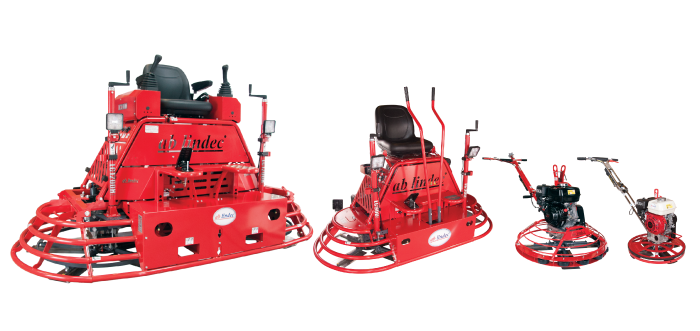What is a power trowel?

A concrete power trowel, also called just a trowel which comes from "to trowel" concrete floors. The trowels are mainly available in two different designs, Walk-Behind Trowels (smaller & lighter) and Riding Trowels (larger & heavier). You sit on the Riding Trowel and you Walk-Behind a regular trowel. These concrete machines are available in a number of different models such as; petrol, diesel or propane engines, electric or battery driven, with manual or hydraulic steering.
AB Lindec® VP436 Walk-Behind Trowel
AB Lindec® LC1200H Riding Trowel
The main advantages of all trowels are primarily quality and service, but rotor speed, power and weight are also important. The higher the quality, the longer the lifetime, but above all to avoid stopping in the middle of pour and if there is no service and no parts nearby, the machine remains standing. The higher the rotor speed, the better the chance of "smoothing" the concrete together, the weight can sometimes be decisive in order to smoothen the floor, in case of very fast hardening, above all during a lot of wind, direct sunlight and high temperatures.
Why are Power Trowels used?
As the concrete "burns" (hardens), the surface must be worked with a Walk-Behind trowel or Riding Trowel to achieve the absolute best; flatness, density, hardness and gloss. This is done in different steps. Initially, a so-called Pan is used on the machines, which are most commonly made of an approx. 3 mm thick flat steel in various sizes from 60 cm to 158 cm in diameter. The Pan are round and are adapted to the diameter of the trowel's rotor spider cross and protective ring.
Panning with pans;
Panning normally starts when you have approx. 1 mm footprint in fresh concrete (unhardened) or just when you can run the Trowel without it so-called "ramping" the concrete. When panning begins, water/liquid is drawn to the surface and makes it more wet. The panning must be done in both directions to enable the best flatness, the panning must also be done several times to achieve the best density, strength and deep shine. ATTENTION! if hard concrete/Dry shake hardeners is to be used, the surface must always be panned before applying the hard concrete/dry shake hardeners.
AB Lindec® Pans
Trowel Blades;
When the panning is considered completed, the concrete must also be "smoothed" with blades. Smoothing with blades of the concrete is done with so-called "Trowel blades" that sit on either on a four, five or six-bladed rotor and have one smoothing blade per each trowel arm. The smoothing with Trowel blades also takes place in both directions for even better flatness, density, hardness and shine. These blades are normally made of approx. 2 mm thick spring steel, which have different designs depending on what type of machine it is and what different surface results are desired.
AB Lindec® Trowel Blades
Other areas of use trowels;
Both regular Walk-Behind Trowels and Riding Trowels are also used for cleaning, impregnating and polishing concrete floors. This also often happens in combination with a hardener or so-called densification. Normally, a scrubbing nylon is attached to a special Pan that contains different amounts of diamonds, depending on the end result you want to achieve. You can say that different "grits" determine what the abrasive nylon or diamond will achieve, the lower the grit makes it more ruff, the higher the grit the finer. NOTE that all diamond grinding has different steps that must be fulfilled, i.e. you cannot jump from 100 grit to 1500 grit, but must take the steps all the way.
AB Lindec® Hardener/densification
AB Lindec® LC900B Battery Riding Trowel

